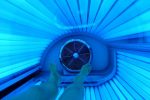Currently, many campus housing properties offer free use of tanning beds as an amenity for college students. Although it may sound nice to have an all-year summer tan, scientists have linked many dangers to tanning beds.
These dangers often fly under the radar because of how easily accessible the tanning beds are to college students. Because of this, many people are unaware of the risk they are putting themselves under in order to achieve their bronzed complexions.
Recently, the rise of skin cancer in young adults has contributed to some frightening statistics. Melanoma, one of the most common forms of skin cancer, is life-threatening.
Additionally, almost 90 percent of skin cancers are caused by ultraviolet rays. UV rays are naturally produced by the sun, but they can also come from artificial light sources. In fact, experts say that the UV rays from tanning beds are almost three times as intense as the rays produced by the sun.
Despite the dangers UV rays have on the skin, campus housing units across the nation continue to offer tanning beds that look safe. Unfortunately, plenty of college students keep using the tanning beds without any real knowledge of the risks behind them. As a result, without proper education on the hazards of UV rays, college students can become oblivious to the risks.
Some indoor tanning salons claim that tanning beds can help boost vitamin D levels, but the claims are false. In fact, numerous health officials have researched the correlation between tanning beds and skin cancer which significantly can raise your chances of jeopardizing your health.
According to the Melanoma Research Foundation, young adults between 25 – 29 years old are the most common victims of melanoma. Also, melanoma is the number one cause of cancer-related deaths for women between 25 – 30 years old. These striking statistics are hardly mentioned by campus housing, which only further contributes to the rise of skin cancer.
Judging from the 125 top-rated colleges from the U.S. News and World Report, almost half of them gave their college students access to tanning beds. Smoking and drinking may get a bad rap due to their long-term health effects, but people who speak out against the long-term health effects of tanning rarely do. However, both can be equally dangerous.
Fortunately, a handful of states, such as California and Nevada, have been somewhat proactive by setting laws to ban tanning beds from anyone under the age of 18. However, tanning beds can still be accessed after the age of 18 and before the age of 35, even though people in that age range are more prone to skin cancer.

Additionally, tanning can make many people feel more confident in their own skin, which often leads to a silent addiction. As a result, many students utilize the free tanning beds offered by their campus housing properties several times a week. While short-term use of tanning beds can enhance your appearance, long-term use can pose fatal consequences. For example, just one indoor tanning session can raise your chances of getting melanoma by 20 percent.
Premature aging, wrinkles, eye problems and a 75 percent higher risk of contracting melanoma are just a few of the things that come along with tanning bed usage before the age of 35. As tempting as it may be to have a year-round summer tan, there are safer ways to go about it that will save you medical treatments and doctor visits.
There’s no doubt that a suntan can really enhance your appearance and make you feel confident. The tanning bed on your campus housing property may appear to be a quick solution to obtaining that perfect, healthy glow, but there’s really nothing healthy about it.
What might make you look sun-kissed now may leave you with an ugly scar down the line or maybe something even worse. It’s important to know the dangers behind tanning beds due to their increasing popularity among campus housing properties.
When something is free, easily accessible and capable of giving you a Cabo vacation glow, it’s definitely enticing to give it a try. But don’t forget that those results are temporary, and the glow is only skin deep. After all, what’s happening below the surface of your skin can cause more harm than good in the future.
So next time you’re thinking about going down to your leasing office to hop in the tanning bed, opt for a spray tan or swing by your local drug store to pick up a self-tanner instead. At the end of the day, a faux glow will still give you the tan you want without creating any future negative side effects.











